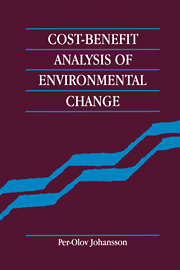Book contents
- Frontmatter
- Contents
- List of figures
- Preface
- 1 Introduction
- 2 Some basic concepts
- 3 Consumer surplus measures
- 4 Valuing public goods: practical methodologies
- 5 General equilibrium cost-benefit rules
- 6 Cost-benefit rules, national income accounts and sustainable development
- 7 Valuation and aggregation: intragenerational and intergenerational issues
- 8 Cost-benefit rules in a risky world
- 9 Valuing changes in access conditions, health risks and information
- 10 Empirical applications
- 11 Policy instruments and international environmental problems
- Notes
- References
- Index
8 - Cost-benefit rules in a risky world
Published online by Cambridge University Press: 15 January 2010
- Frontmatter
- Contents
- List of figures
- Preface
- 1 Introduction
- 2 Some basic concepts
- 3 Consumer surplus measures
- 4 Valuing public goods: practical methodologies
- 5 General equilibrium cost-benefit rules
- 6 Cost-benefit rules, national income accounts and sustainable development
- 7 Valuation and aggregation: intragenerational and intergenerational issues
- 8 Cost-benefit rules in a risky world
- 9 Valuing changes in access conditions, health risks and information
- 10 Empirical applications
- 11 Policy instruments and international environmental problems
- Notes
- References
- Index
Summary
In general, cost-benefit rules are derived under the assumption that there is no uncertainty. In order to handle uncertainty, the cost-benefit practitioner usually performs a sensitivity analysis. To illustrate, suppose the analysis is based on an oil price of $20 per barrel, and that the investigator considers it extremely unlikely that the price will fall below $15 or rise above $30. Then the project is re-evaluated using these alternative oil prices. This is, however, a primitive way of handling risk and uncertainty. In particular, it implies that no distinction is made between evaluation uncertainty and project uncertainty. Evaluation uncertainty refers here to the fact that owing to poor data quality, missing data, etc., the investigator may be uncertain about the project's effects even if there is no underlying uncertainty. Project uncertainty or risk, on the other hand, refers to stochastic incomes, prices, environmental quality, etc. This chapter concentrates on project risk and derives cost-benefit rules that can be used to assess environmental changes of which the consequences are not known in advance. The chapter turns directly to project assessments but for convenient reference the appendix contains definitions of risk attitudes and similar concepts. An empirical study based on the money measures defined in this chapter is presented in section 10.3.
The chapter is structured as follows. The first section presents a simple atemporal framework for the analysis of risk. Households face an uncertain supply or quality of an environmental asset, but prices and incomes are known with certainty. A willingness-to-pay locus is introduced illustrating the fact that there is possibly an infinite number of money measures of utility change in a risky world.
- Type
- Chapter
- Information
- Cost-Benefit Analysis of Environmental Change , pp. 133 - 155Publisher: Cambridge University PressPrint publication year: 1993



